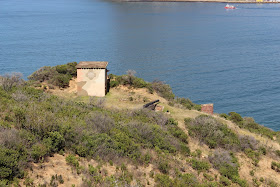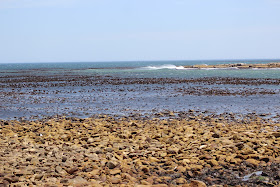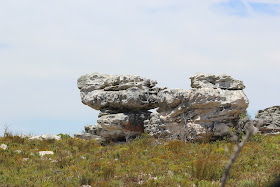As I sit at the computer, I am surrounded by a barren apartment and our packed bags. After 351 days, our Namibian adventure is coming to its end - and what an life changing and fabulous adventure it has been. It rained a little today which probably is symbolic for our mood and emotions. Excited about returning home to see our family and friends but sad to leave such a beautiful country and people. Namibia has become our home but as the saying goes "all good things must eventually come to an end."
But I would be greatly amiss and ungrateful to end the adventure without acknowledging and thanking the many people and institutions that have made this Fulbright experience possible.
First, I would like to thank the Fulbright Commission for awarding me the grant that made the whole experience a reality. The Fulbright program is sponsored and funded by the U.S. State Department. Hopefully, the politicians will continue to recognize the importance of such cultural exchanges. True and lasting peace in the world can only be accomplished through mutual dialog and communication among countries and people from diverse backgrounds and cultures.
Second, I must thank the Namibian University of Science and Technology (NUST) and the Department of Civil and Environmental Engineering which hosted me during the year. They provided our fully furnished apartment, an office space, and considerable support in navigating the institutional bureaucracy and processes. I hope to continue to build on the collaborations that I have developed during my tenure.
Next, my home institution of the University of North Carolina at Charlotte and the Department of Engineering Technology and Construction Management for supporting and funding my sabbatical leave. I know that it required many colleagues to take on additional responsibilities and classes in my absence.
The students I have taught and mentored while at NUST has made the experience truly educational. I know I learned much more from them than anything I taught them. And I look forward to continuing to mentor and work with some of them after I return to the States.
I express sincere gratitude to the members of the Windhoek Branch of the Church of Jesus Christ of Latter Day Saints. The congregation has been our family while in Namibia and their friendship made us feel at home from the moment we arrived in Namibia. Their faithfulness and diligence in living the Gospel of Jesus Christ has been an inspiration.
My love goes out to my kids and family at home. They have supported us in all ways while we were gone including looking after our house. Fortunately, some of them (a total of nine) had the opportunity to visit us during the year and experience Namibia for themselves.
Finally, my eternal love and gratitude must go to my wife, Karen. She has been by my side for all of our Namibian adventures. It has been a truly team effort and none of the adventures would have had the same meaning and impact without her companionship. Anything I have ever achieved has been possible only because of her unfailing support.
We do not know what the future may hold. We hope to come back to Namibia in some capacity. God may some other adventures in store for us. Only time will reveal the answer.
So, here is a fond farewell to our Namibia. A part of our hearts will always be Namibian.
Tuesday, December 19, 2017
Thursday, December 14, 2017
Cape Town and Table Mountain
Cape Town is a very large (population 3.75 million) and cosmopolitan city with an affluent tourist and business sector. The city surrounds the base of Table Mountain and has a long beach front with a nice harbor area. Lots of hotels, lots of restaurants, lots of tourists, and lots of traffic. After a year in Namibia, the crowds, congestion and traffic was a little disconcerting. Many of the roads were very narrow with cars parking on both sides making it particular hard for large vehicles and trucks to maneuver which caused long backups. We were glad that we had a year of driving on the left-side of the road under our belts before driving in Cape Town. We opted to use a hop-on, hop-off double decked tourist bus to get around.

The harbor area has a Ferris wheel, the upscale Victoria & Alfred shopping mall, restaurants, and souvenir shops. We took a short cruise through the harbor. We had wanted to visit Robben Island where Nelson Mandela and other apartheid foes had been imprisoned but it turned out we didn't have the proper identification documents with us and it was fully booked by the time we were able to return. So, that was a disappointment.
Of course, the big attraction is Table Mountain. The mountain looms 3,600 feet over the city and the top is accessed with cable cars. The views were fantastic as the sky was perfectly clear with no wind. The downside was that the temperature was really hot (39 degrees Celsius). Lots of unique plants on the top.

We also took a sunset drive to the top of Signal Hill. In some ways, the views were better here than at Table Mountain as you were closer to the city and could more easily identify landmarks and buildings.
On our last day, we took a wider loop around the outer edges of the city and visited the botanical gardens. They had an interesting curving "canopy" bridge that took you through the tree tops.
Also passed by the poorer informal townships where many of the local blacks live. Cape Town did a very good job at hiding the poverty from the primary tourist areas. However, this gave the city a somewhat segregated feel as all you typically saw were white tourists with blacks working in basic service and manual labor jobs. The city appears to have a large income inequality gap.

The harbor area has a Ferris wheel, the upscale Victoria & Alfred shopping mall, restaurants, and souvenir shops. We took a short cruise through the harbor. We had wanted to visit Robben Island where Nelson Mandela and other apartheid foes had been imprisoned but it turned out we didn't have the proper identification documents with us and it was fully booked by the time we were able to return. So, that was a disappointment.
 |
| The Harbor with Signal Mountain in the Background (Lion's Head is on the left) |
 |
| Antarctic Research Vessel that was Docked in the Harbor |
 |
| Victoria and Alfred Shopping Mall |
Of course, the big attraction is Table Mountain. The mountain looms 3,600 feet over the city and the top is accessed with cable cars. The views were fantastic as the sky was perfectly clear with no wind. The downside was that the temperature was really hot (39 degrees Celsius). Lots of unique plants on the top.
 |
| Table Mountain Framed in the Background |

 |
| View of Robben Island |
 |
| View of Camps Bay |
 |
| Looking Down from the Cable Car |
We also took a sunset drive to the top of Signal Hill. In some ways, the views were better here than at Table Mountain as you were closer to the city and could more easily identify landmarks and buildings.
 |
| Table Mountain and Lion's Head |
On our last day, we took a wider loop around the outer edges of the city and visited the botanical gardens. They had an interesting curving "canopy" bridge that took you through the tree tops.
 |
| Quiver Tree |
 |
| Welwitschia Mirabilis |
Wednesday, December 13, 2017
Fond Farewell to Our Dependable Chariot
Unfortunately, we must now say a fond farewell to our dependable chariot as we sold our car. We don't get emotionally attached to such inanimate objects and provide them with names, etc. as some are prone to do. However, the car has been a central component in most, if not all, of our Namibian adventures. We will not be able to reminisce about our travels without recollecting the many hours we spent sitting in and driving the car. It safely transported us over all types of roads and terrain, across international borders, and through a variety of scenic and cultural areas with no mechanical issues (except for three flat tires). And, somehow, it survived our attempts in learning to drive on the left-hand side of the road. So, here goes a shout out to our 2011 Dodge Caliber.
Although departing company with the car, here's hoping that it doesn't mark the permanent end of our Namibian travels. We hope to come back again in the future to see even more of this beautiful country and people.
Tuesday, December 12, 2017
Cape of Good Hope
This past week we were able to spend time in Cape Town South Africa. The area is as beautiful as its reputation. However, my favorite part of the trip was the day we spent driving down the peninsula.
The highway followed along the coast through charming bays and lovely towns.

The rock formations were fascinating.
This eland is the only game life we saw.
The light house at Cape Point. It sits up high on a rocky outcrop and was a bit of a climb up to it. It is still in use today and can be seen 39 miles out to sea. The sea here is very turbulent and rather infamously stormy. The wind was blowing so hard that it was difficult to walk and we had to hang on to the rails to keep from getting blown away. Needless to say, we don't have tons of pictures. It was hard enough just to stand still, let alone focus a camera.
We then drove over to the Cape of Good Hope. Sir Francis Drake called this the "fairest cape in all the world". I am not sure how many capes there are to compare it to, but it is beautiful.
We have now officially been to the most southwestern point of Africa!
Driving back to Cape Town, we followed the highway on the east of the peninsula that follows what is called False Bay. Here we added another animal crossing sign to our growing collection
We were excited when we saw a colony of penguins, not on the road, but on the beach where they belong. These are African penguins aka jackass penguins for their loud braying call. They stand about 28 inches tall and have a black stripe across the chest.
The highway followed along the coast through charming bays and lovely towns.
It was interesting to see the relics of WWII throughout the countryside.
Section of road hugging the cliffs.
Upon entering the Cape of Good Hope National Park, we were able to see different flora than what we are use to in Namibia.

We also came across a new animal crossing sign to add to our collection. Never saw a tortoise though.
The rock formations were fascinating.
The light house at Cape Point. It sits up high on a rocky outcrop and was a bit of a climb up to it. It is still in use today and can be seen 39 miles out to sea. The sea here is very turbulent and rather infamously stormy. The wind was blowing so hard that it was difficult to walk and we had to hang on to the rails to keep from getting blown away. Needless to say, we don't have tons of pictures. It was hard enough just to stand still, let alone focus a camera.
 |
| Birds on the cliffs at the lighthouse. |
Driving back to Cape Town, we followed the highway on the east of the peninsula that follows what is called False Bay. Here we added another animal crossing sign to our growing collection
We were excited when we saw a colony of penguins, not on the road, but on the beach where they belong. These are African penguins aka jackass penguins for their loud braying call. They stand about 28 inches tall and have a black stripe across the chest.
 |
| Some of the younger birds still had downy feathers and were molting, |
Maybe you can tell from Bruce's hair that it had been a windy yet great day!






































